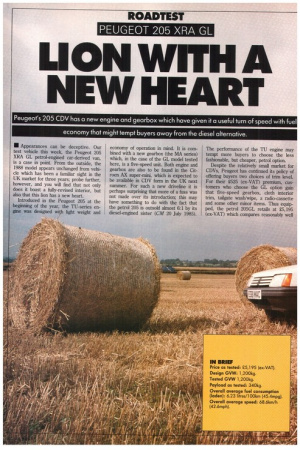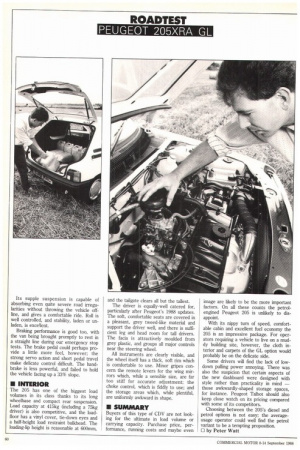LION WITH A NEW HEART
Page 40

Page 41

Page 42

If you've noticed an error in this article please click here to report it so we can fix it.
Peugeot's 205 CDV has a new engine and gearbox which have given it a useful turn of speed with fuel economy that might tempt buyers away from the diesel alternative.
IN Appearances can be deceptive. Our test vehicle this week, the Peugeot 205 XRA GL petrol-engined car-derived van, is a case in point. From the outside, the 1988 model appears unchanged from vehicle which has been a familiar sight in the UK market for three years; probe further, however, and you will find that not only does it boast a fully-revised interior, but also that this lion has a new heart.
Introduced in the Peugeot 205 at the beginning of the year, the TU-series engine was designed wish light weight and
economy of operation in mind. It is combined with a new gearbox (the MA series) which, in the case of the GL model tested here, is a five-speed unit. Both engine and gearbox are also to be found in the Citroen AX super-mini, which is expected to be available in CDV form in the UK next summer. For such a new driveline it is perhaps surprising that more of a fuss was not made over its introduction; this may have something to do with the fact that the petrol 205 is outsold almost 6:1 by its diesel-engined sister (CM 20 July 1985).
The performance of the TU engine may tempt more buyers to choose the less fashionable, but cheaper, petrol option. Despite the relatively small market for CDVs, Peugeot has continued its policy of offering buyers two choices of trim level. For their 2525 (ex-VAT) premium, customers who choose the GL option gain that five-speed gearbox, cloth interior trim, tailgate wash/wipe, a radio-cassette and some other minor items. Thus equipped, the petrol 205GL retails at £5,195 (ex-VAT) which compares reasonably well with Austin Rover's Metro 310L 1.3 (24,970) and Renault's 5TR (24,550).
• PERFORMANCE
In the city-centre Grand Prix the plucky little Peugeot gives a good account for itself — provided the driver is willing to keep the engine revs high. For while the new 1,124cc unit is 10% more powerful than its predecessor at 40kW (55hp), this increase has been achieved at the expense of a certain degree of flexibility (maximum torque comes 4 0Orpm higher at 3,200rpm). The slick-shifting gearbox proves a good ally and, using the wellchosen ratios sensibly, a driver will have little difficulty staying ahead of the pack, particularly when lightly laden.
On the motorway the 205 is especially impressive. With the overdrive fifth gear keeping engine speed (and thus engine wear and noise levels) down, the Peugeot tbau' s no problem in maintaining the legal . I; only on very steep gradients does e driver have to resort to changing into urth. , An indication of the engine's lack of w-down pulling power was given' in the ' hill-restart tests. Fully laden, the van if it could only just scramble away from rest on a 25% slope, and in deference to the clutch, the 33% ramp was not attempted. Under normal conditions the clutch performs well, with only moderate pedal effort required, although the travel was quite short and could occasionally catch the driver unawares.
• ECONOMY
Peugeot's engineers have clearly got their sums right when it comes to the fuel efficiency of the new engine. Around the light-van test route the 205 set new standards for the petrol-engined CDV class, recording 6.23 litres/100km (45.4mpg) with a 415kg payload (including a 75kg driver). The unladen figure was equally impressive at 5.35 litres/100km (52.8mpg).
As our comparison charts show, none of the 205's petrol-engined competitors can match its combination of economy and payload. It will be interesting to see how the forthcoming Citroen AX fares, with an identical engine and gearbox but with superior aerodynamics and lower unladen weight.
A more important comparison for many prospective buyers is between the petrol and diesel versions of the 205. Around the same course the diesel achieved 5.29 Iitres/100km (53.3mpg) with a slightly smaller 405kg payload, and 4.67 litres/ 1001cm (60.4mpg) unladen. With a price differential of 2515 (ex-VAT), a rough calculation reveals that the break-even yearly distance to recoup the extra cost through savings in fuel bills is in excess of 80,000km.
The new engine has been designed for ease of maintenance, and the gearbox is a sealed unit, so servicing costs should be low. Access to regularly serviced items is good, with plenty of room in the engine bay.
• HANDLING
The Peugeot 205 has a reputation for good handling which our test vehicle lived up to. The steering is pleasantly weighted, and gives a reasonable level of feedback to the driver. Road holding is also secure, although the narrow tyres limit the amount of grip available. As speeds increase the 205's natural tendency is to understeer, lifting-off tightened the line, and in extreme instances led to oversteer.
Its supple suspension is capable of absorbing even quite severe road irregularities without throwing the vehicle offline, and gives a comfortable ride. Roll is well controlled, and stability, laden or unladen, is excellent.
Braking performance is good too, with the van being brought promptly to rest in a straight line during our emergency stop tests. The brake pedal could perhaps provide a little more feel, however; the strong servo action and short pedal travel make delicate control difficult. The handbrake is less powerful, and failed to hold the vehicle facing up a 33% slope.
• INFERIOR
The 205 has one of the biggest load volumes in its class thanks to its long wheelbase and compact rear suspension. Load capacity at 415kg (including a 75kg driver) is also competitive, and the loadfloor has a vinyl cover, tie-down eyes and a half-height load restraint bulkhead. The loading-lip height is reasonable at 600mm, and the tailgate dears all but the tallest.
The driver is equally-well catered for, particularly after Peugeot's 1988 updates. The soft, comfortable seats are covered in a pleasant, grey tweed-like material and support the driver well, and there is sufficient leg and head room for tall drivers. The facia is attractively moulded from grey plastic, and groups all major controls near the steering wheel.
All instruments are clearly visible, and the wheel itself has a thick, soft rim which is comfortable to use. Minor gripes concern the remote levers for the wing mirrors which, while a sensible size, are far too stiff for accurate adjustment; the choke control, which is fiddly to use; and the storage areas which, while plentiful, are uniformly awkward in shape.
• SUMMARY
Buyers of this type of CDV are not looking for the ultimate in load volume or carrying capacity. Purchase price, performance, running costs and maybe even image are likely to be the more important factors. On all these counts the petrolengined Peugeot 205 is unlikely to disappoint.
With its nippy turn of speed, comfortable cabin and excellent fuel economy the 205 is an impressive package. For operators requiring a vehicle to live on a muddy building site, however, the cloth interior and carpets of the GL option would probably be on the delicate side.
Some drivers will find the lack of lowdown pulling power annoying. There was also the suspicion that certain aspects of the new dashboard were designed with style rather than practicality in mind — those awkwardly-shaped storage spaces, for instance. Peugeot Talbot should also keep close watch on its pricing compared with some of its competitors.
Choosing between the 205's diesel and petrol options is not easy; the averageusage operator could well find the petrol variant to be a tempting proposition.
El by Peter Watt














































